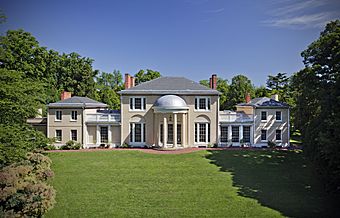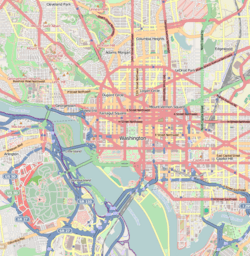Tudor Place facts for kids
|
Tudor Place
|
|

South façade.
|
|
| Location | 1644 31st Street, NW Washington, D.C. |
|---|---|
| Area | 5.5 acres |
| Built | 1815 |
| Architect | Dr. William Thornton |
| Architectural style | Federal |
| NRHP reference No. | 66000871 |
Quick facts for kids Significant dates |
|
| Added to NRHP | October 15, 1966 |
| Designated NHL | December 19, 1960 |
Tudor Place is a beautiful old house in Washington, D.C.. It was built in the Federal style, which was popular in the early 1800s. This mansion was once the home of Thomas Peter and his wife, Martha Parke Custis Peter. Martha was the granddaughter of Martha Washington, America's first First Lady. Tudor Place sits on a hill in Georgetown Heights. From here, you can see a great view of the Potomac River.
Contents
The Story of Tudor Place
Building a Grand Home
The land where Tudor Place stands was once part of a larger area called "Rock of Dumbarton." In 1794, a man named Francis Lowndes bought some of this land. He started building the two side parts, or "wings," of the house. However, he never finished it.
In 1805, Martha and Thomas Peter bought the property. They hired Dr. William Thornton to finish their home. Dr. Thornton was a famous architect who also designed the United States Capitol building. He connected the two wings with a central part and added a grand "temple" porch with columns. He used buff-colored stucco over brick to make the house look grand.
Treasures from the Past
Tudor Place is special because it holds many items that belonged to George Washington and Martha Washington. It has the largest collection of their belongings outside of Mount Vernon, their famous home. Imagine seeing things they actually used! These include special chair cushions embroidered by Martha Washington herself. She also embroidered trimmings for a decorative bed cover.
Life at Tudor Place: People and History
Many people lived and worked at Tudor Place over the years. This included enslaved workers and domestic servants. Martha Parke Custis Peter inherited about 90 enslaved people from her grandmother, Martha Washington. Tudor Place today helps us understand this part of history.
In 1811, Martha Peter's mother, Eleanor Calvert, passed away at Tudor Place. Martha was glad she could spend her mother's last two weeks with her in the house.
Important guests also visited Tudor Place. In 1813, Josiah Quincy III, a U.S. educator and politician, visited with his wife. During their visit, Mrs. Peter gave Josiah a special item: General Washington's silver gorget. A gorget was a metal collar worn to protect a soldier's throat. George Washington wore this gorget in a famous painting from 1772. Mrs. Peter had received it when her grandfather's belongings were divided.
Another important visitor was Timothy Pickering, a former U.S. Secretary of State. He visited the Peters at Tudor Place in 1815 and 1816.
Family Life and Famous Visitors
Thomas and Martha Peter raised eight children at Tudor Place. They also hosted the Marquis de Lafayette in 1824. Lafayette was a French hero who helped America win its independence.
Their eldest son, John Parke Custis Peter, later built a smaller version of Tudor Place called Montevideo. This was on a farm near Seneca, Maryland. This farm also had the Seneca Quarry, which provided stone for the Smithsonian Institution Building.
After Martha Peter passed away in 1854, her daughter Britannia Peter Kennon became the owner. She was the widow of Commodore Beverley Kennon I.
Around 1869, Robert E. Lee, a famous general from the American Civil War, visited Tudor Place. This was his last visit to Washington, D.C., before he passed away in 1870.
Tudor Place Today
Tudor Place was recognized as a National Historic Landmark in 1960. This means it's a very important historical site. Today, Tudor Place is open to the public. You can visit and learn about its history, its beautiful architecture, and the fascinating collections inside. It's located at 1644 31st Street, N.W.
Images for kids
-
Library of Congress 1999 Historic American Buildings Survey No. DC 171 Architectural Drawing of the South Elevation of Tudor Place at 1:48 scale.
-
Library of Congress 1999 Historic American Buildings Survey No. DC 171 Architectural Drawing of the Ground floor plan of Tudor Place at 1:48 scale.
-
Library of Congress 1999 Historic American Buildings Survey No. DC 171 Architectural Drawing of the garden plan and tree schedule at 1:300 scale.
-
A 1772 portrait of Colonel George Washington by Charles Willson Peale shows Washington's gorget, given to Josiah Quincy III in March 1813 by Martha Parke Custis Peter at Tudor Place.
See also
- Architecture of Washington, D.C.












